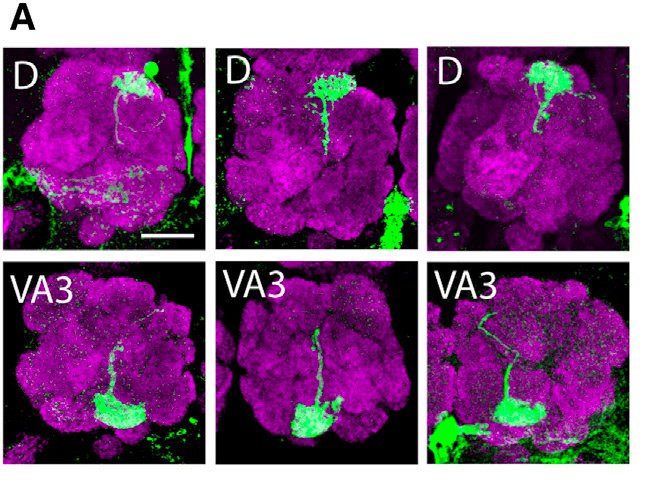Capturing the Right Odors to Study the Brain
Over the summer, Betty Hong, assistant professor of neuroscience, spent a week at the Janelia Research Campus in Ashburn, Virginia, interacting and brainstorming with other researchers from around the country interested in olfaction, our sense of smell. Invited to participate by the National Science Foundation (NSF), these 30 computational and experimental neuroscientists came up with innovative ways to approach some of the mysteries about how the brain processes odors and uses that information to guide behavior.
The five-day session was an example of the agency's new funding mechanism, the Ideas Lab. At these meetings, a multidisciplinary group of researchers is charged with generating potentially transformative proposals on a focused research topic. Now the NSF has awarded $15 million to three projects from the Olfactory Ideas Lab. Hong is coprincipal investigator on one titled "Using natural odor stimuli to crack the olfactory code." The awards expand NSF's investments in President Obama's BRAIN Initiative.
"I am grateful to have had the opportunity to be thrown together for a week with such a smart, diverse group of scientists who approach olfaction from so many different angles," says Hong (BS '02), adding that without the Ideas Lab, it is unlikely that she would have ever established collaborations with her coinvestigators. "I am also extremely grateful to the NSF for including junior investigators like myself who are just kicking off their research program. This unique funding mechanism will enable us to tackle really challenging and innovative research right at the start of our careers."
Olfactory scientists typically use simple synthetic odors involving single molecules for their experiments because natural odors—those that we smell around us every day—are too difficult to reproduce in a reliable way under controlled conditions. However, those simplified stimuli may not trigger the full range of neural computations that constitute olfaction.
Therefore, Hong and her colleagues aim to use comprehensive chemical analysis and computational methods to construct reproducible synthetic odorants in the lab that mimic naturally occurring smells in terms of eliciting typical behavioral responses in honey bees, fruit flies, and fly larvae. (Hong specializes in studies of the fruit fly Drosophila.) These synthetic odor blends can then be used to investigate how the brain processes smells and orders specific adaptive behaviors.
"We believe probing the olfactory circuit with naturalistic stimuli will reveal long-hidden computational features of the circuit," Hong explains. "Much as higher-order visual neurons only respond to complex stimuli like faces or hands, and not to simple bars and dots, we hypothesize that naturalistic odor stimuli will reveal novel features of odor space that the olfactory system encodes, which may only become apparent once appropriate sets of stimuli are used."
Along with Hong, additional principal investigators on the project are Brian Smith of Arizona State University; Aravinthan Samuel of Harvard University; and Tatyana Sharpee of the Salk Institute for Biological Studies. The project will receive $3.6 million over three years.
 The compact size of the fly brain makes it possible to visualize neural activity across an entire neural circuit. Hong and her colleagues used two-photon imaging to measure calcium signals originating from distinct neuronal populations in olfactory circuits deep in the fly brain. These images show that different odors elicit distinct patterns of activity in primary sensory neurons (B), but invariant patterns in local inhibitory neurons (D).
Credit: E.J. Hong/Caltech
The compact size of the fly brain makes it possible to visualize neural activity across an entire neural circuit. Hong and her colleagues used two-photon imaging to measure calcium signals originating from distinct neuronal populations in olfactory circuits deep in the fly brain. These images show that different odors elicit distinct patterns of activity in primary sensory neurons (B), but invariant patterns in local inhibitory neurons (D).
Credit: E.J. Hong/Caltech
 By including a dye in the recording electrode when they study individual neurons, researchers can relate the anatomical structure of those neurons (green) to their recorded functional properties. The rest of the brain is stained in magenta. One of the reasons experimentalists use fly circuits is that they are often highly stereotyped--individual neurons with the same connectivity and the same response properties can be found in every animal, as in the VA3 and D olfactory neurons shown here.
Credit: E.J. Hong/Caltech
By including a dye in the recording electrode when they study individual neurons, researchers can relate the anatomical structure of those neurons (green) to their recorded functional properties. The rest of the brain is stained in magenta. One of the reasons experimentalists use fly circuits is that they are often highly stereotyped--individual neurons with the same connectivity and the same response properties can be found in every animal, as in the VA3 and D olfactory neurons shown here.
Credit: E.J. Hong/Caltech


